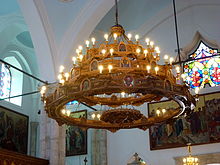Agios Titos (Heraklion)
Agios Titos ( Greek Άγιος Τίτος ) is an Orthodox church building in the center of the old town of Heraklion (Heraklion). It belongs to the Archdiocese of Crete and houses the skull relic of St. Titos.
history
In the year 55 AD, the apostle Paul and his companion Titus may have been in Gortyn , the capital of Crete. Here Paul consecrated Titus as the first bishop of Crete and commissioned him to proselytize Crete. According to tradition, Titos had an episcopal church built. He is said to be buried there.
After the division of the Roman Empire in 395 AD, Crete came under Byzantine rule. The successful Christianization made it necessary to build a new church in Gortyn around 600. Around 826, the Saracens conquered Crete, destroyed Gortyn and the church, and founded Crete's new capital, Heraklion. In 960, Nikephoros Phocas recaptured Crete for the Byzantine Empire and drove the Arabs out of Crete. The bishopric of Crete was moved to Chándakas . Nikephoros Phokas is said to have built a church on the site of today's church in 962. After the Fourth Crusade of 1204, Crete fell to the Venetians and the church became the Roman Catholic cathedral of the Archdiocese of Heraklion. In 1544 the church burned down completely, only the skull relic of St. Titos could be saved. In 1669 the Turks conquered Crete and the church was converted into a mosque . The Venetians took the skull relic of St. Titus with them to Venice. The building was destroyed by an earthquake in 1856; it was rebuilt in the Ottoman style by 1872. Crete became autonomous in 1898 and joined Greece in 1913.
In the course of the population exchange between Greece and Turkey , the Muslim minority had to leave Crete, the mosque was converted into an Orthodox church building, which was consecrated to St. Titos after its completion in 1925. In 1966 the skull relic of St. Titos returned from Venice to the Agios Titos Church in Heraklion.
architecture
Outside
The type of construction of the Agios Titos Church is a mosque oriented towards Mecca with a square floor plan and a central dome . The building is made of light sandstone , the front and sides are almost the same in their wall structure. In addition to the main entrance, it has two other wide side entrances with double-leaf wooden doors. When the mosque was converted into a church after 1923, three apses and a bell tower were added in the southwest corner.
Inside
The church interior is accessed through the anteroom ( narthex ). The central dome rises above the belt arches that rest on narrow bundles of columns. A mixture of Gothic , Classical , Byzantine and Ottoman style elements can be recognized. The nave is divided by a picture wall, the iconostasis . This prevents the view of the chancel . A narrow chapel adjoins the anteroom on the left, in which the skull relic of St. Titos is kept in a gold-glass reliquary . To the right of the anteroom is the administration room. The stained glass windows , five on each side of the building, show different saints and make the interior light and friendly.
Furnishing
The decoration of the church interior with woodwork from a uniform period of origin impresses with its harmony and inner unity.
The iconostasis
The iconostasis separates the faithful from the clergy at the liturgy , who only have access to the sanctuary behind the iconostasis.
The history of salvation is represented by the icons in the top row . In the lower row there is the double-winged royal door , above which the Lord's Supper on Maundy Thursday is shown in a round arch field . To the right of the royal door, the icon shows the enthroned Jesus with the open gospel , next to him the icon of John the Baptist , to the left of the double door the Mother of God ( Hodegetria ), on her side the apostles Peter and Paul and the archangel Michael . Two more double doors are located at either end of the iconostasis. With the archangels, they remember the expulsion from paradise .
The chandelier
The massive, round chandelier hangs in the middle of the nave exactly under the dome. It is three-story and made of wood . The fine carvings depict animals of various species and ornaments .
The seating
The seating made of light and dark wood adapts to the icons of the iconostasis thanks to the semicircular backrests .
Icons
Large, rectangular icons adorn the walls and show the life of St. Titos and the history of salvation. Some icons, richly decorated with silver and gold , mostly dedicated to Panagia , stand on pedestals or are depicted in small altars . The icon of the Virgin of the Burning Bush to the right of the entrance is particularly striking.
Relic of St. Titus
From the vestibule to the left there is a chapel. On the altar in the right side niche is the skull relic of St. Titus. The gold and silver reliquary set with diamonds shows icons and is protected by a glass attachment.
candle holder
Numerous candlesticks filled with sand in the back area of the church are used to set up and light candles in order to show the worship of God, for example through an icon.
gallery
literature
- Archbishop Kyrill, Johannes Kogerakis: Άγιος Απόστολος Τίτος: Ακολουθίαι και αγιολογικά κείμενα ( The Church of St. Titus . The Succession and the Holy Scriptures ). Ιερός Ενοριακός Ναός Αγίου Τίτου Ηρακλείου, Iraklio 2004, ISBN 960-87955-1-6 .
Web links
Coordinates: 35 ° 20 '24.4 " N , 25 ° 8' 5.1" E











